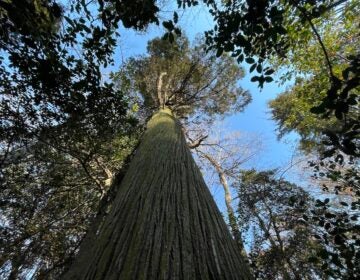Edible mushrooms start sprouting across Delaware Valley after rainy summer months
Morning Edition host Jennifer Lynn talks with mushroom expert Linda Brynan Sears about the different mushrooms that have begun sprouting around our area.
Listen 5:18
Pseudoboletus parasiticus in Wolf's Hollow near Atglen, Pa. (Courtesy of John Dawson)
Following a drenching summer rain, an edible mushroom called chicken of the woods has been spotted around our area. It’s sometimes massive with broad streaks of orange and yellow crowning toward its edges.
Morning Edition host Jennifer Lynn found some last week on a fallen tree, picked it, and then rounded up a local mushroom expert to help her identify it.
Linda Brynan Sears has been a mushroom hunter for 30 years and has studied fungi for the last 12. She’s the Foray Chair of Eastern Penn Mushroomers. A foray is a group trip into the woods to look for fungi.
She’s been hunting for mushrooms on her own these days, due to social distancing. Jennifer showed Sears her mushroom on Zoom.
–
You have it. That is Chicken of the Woods. That is the Laetiporus Cincinnatus. That is an excellent edible, and it tastes like chicken.
Wow, well that’s great!
By the way, what you’re picking there is like picking a piece of fruit. A mushroom is the reproductive organ of the fungus. That’s how it creates spores and begins the process of reproducing.
I did not know that. Well, I got lucky to find the chicken of the woods about a week ago. And then also hiking around, I came across these bright orange, delicate little mushrooms that when I went online to look up the pictures, I found that they were cinnabar chanterelles. And they are very desirable, apparently really delicious, right?
Yes, they are. Those are wonderful. And they have another highly prized gourmet mushroom called the golden chanterelle. And that will be much larger and sort of a yellow-orange. Both of those are definitely highly prized edibles.

So it is the season for mushrooms or is the entire year a season for mushrooms?
It depends. Different mushrooms come out at different times. We foray as a club right up to the first week in December. Now we had a very, very hot July and dry. So not much was coming up once Isaias came through. It’s insane. Yesterday, I went on a short quarter-mile walk and I counted no less than twenty-eight different species of Boletus alone.
What did you find? “Boll-eets?”
Boletus, yes, it’s a typical mushroom shape, usually very cushion-shaped on top. On the cap, underneath, it has a sponge-like surface.
So what did the tropical storm do to our environment to make these mushrooms just go hog wild?
It added water. That’s all they needed. They’re very thirsty little buggers.
And they don’t last very long, do they?
No, they usually don’t. Some of these Boletus will be gone in two days. Some overnight. There are some of these little, delicate, long mushrooms that will be gone within hours.
What is the purpose of a mushroom in nature?
Mushrooms can be very beneficial to the environment. They help absorb nutrients and the nutrients that the plants create are transferred back to the mushrooms. Now, that’s called a mycorrhizal relationship. They have removed mushrooms and all fungi from an area to study and see what would happen. And the plants only grow at about 20-25% of their normal range. The other thing is, if we didn’t have the mushrooms that break — saprophytic mushrooms — that break things down, plants that fall down would just stay there and not break down. Mushrooms are the only thing that can break down cellulose.
Pretty amazing. And you say the number of species in Pennsylvania alone is in the thousands?
8,000 that they’ve identified. I’m not counting all the ones that even our club has found that have been new species. In fact, just yesterday I sent off some samples of an Agaricus that I have found back here to an expert, and he’s probably going to do some DNA analysis. It might be a new species.
Will they name it after you?
Probably not. You know, they’ll give me some credit somewhere and some scientific paper.
“Lindus Searus” fungus?
Yeah, it might happen. You never know.

Get daily updates from WHYY News!
WHYY is your source for fact-based, in-depth journalism and information. As a nonprofit organization, we rely on financial support from readers like you. Please give today.





